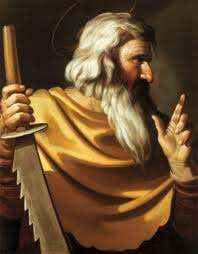The feast day of St. Jude and St. Simon, apostles, is
October 28 (celebrated on the 29th when the 28th falls on
a Sunday as happens this year). In the
various lists of the Apostles found in the New Testament, Simon and Jude fill
the 10th and 11th seats.
Although, there is even speculation about that! Some Biblical scholars believe the “twelve”
was simply an arbitrary number assigned and that apostles were replaced in the
event of death or apostasy (renunciation of the faith).
Simon and Jude were common names in Jesus’ time and among
Jesus’ disciples. In fact half of the
apostles shared names: Jude and Judas, Simon Peter and Simon Cananean (the
zealot), James the greater and James the less.
It is easy to confuse identities and lose individual stories. This is the case with both Simon and
Jude. So little is known about either
apostle that only speculation remains. Here
are your options; choose the one that brings you best comfort!
Both Jude and Simon are mentioned as being Jesus’ younger brothers,
along with James. In fact, it seems their
brother Joseph was the only one to stay home.
But the gospel also mentions the second Simon to be chosen as one of the
Holy Twelve was Simon Cananean. Cananean
derives from the Greek word meaning “zealot” and does not refer to the
place. Would one of Mary’s sons have
become enthralled by the violent zealot party, bound to raise an army against
Rome? And yet, historians do consider
that the Cananean reference was indeed a reference to Simon’s hailing from
Cana. Many place him as the son of
Clopas and the bridegroom at the wedding where Jesus performed his first
miracle. So with Simon, you have three
choices (or some combination of the three):
- Jesus’ baby brother who followed him around through some notion of sibling hero-worship;
- a zealot whose ulterior motive was to convince Jesus to gather his over 50,000 devoted followers into an army to fight against the Roman Occupation;
- the son of Clopas and bridegroom at the famous wedding (and who, one would presume left his new bride—or dragged her along with him— to follow Jesus around the countryside to what end one can only speculate).
Jude is no easier to identify than Simon! Jude is commonly interchanged with Thaddeus. This also is due to some interesting
linguistic twists. The name Judah, with
an –ah ending is the same as Judas with an –as ending (hence names like
Elijah=Elias, Jonah=Jonas, etc.) and anglicanizing the –ah spelling often
transposed to –e endings (which were at one time pronounced). Now, the name Judas is a variant on the Greek
word for “godlike,” theudas, which
alternate spelling of “Thaddeus” came to be an equivalent name to Jude. (Think equivalencies as Peggy is to Margaret
or Dick is to Richard.) Thus, the common
connection of Jude Thaddeus is to differentiate this apostle from Judas
Iscariot. Like Simon, Jude is also
identified as being a younger brother of Jesus or the son of Clopas and the bridegroom at the wedding. Thaddeus (and tradition connects this
Thaddeus to Jude) was also considered to be one of the Seventy (thus not one of
the original twelve) who was sent to Edessa.
However, there is a charming story about Jude, the Apostle that is
perpetuated in art wherein Jude carries a portrait of Jesus. The story goes something like this:
King Abgar of Edessa, in what is now
part of southern Turkey, was gravely ill.
He had been visited my man, many renowned and gifted physicians to no
avail. He’d heard of the miracles of one
Jesus of Nazareth and as a last resort, he wrote to the man asking him to come
to Edessa to heal him. (Agbar was not a true believer, but in desperation would
grasp at any opportunity for relief.) Amongst
the party with the messenger, Agbar had sent and artist to render a likeness of
Jesus that Agbar and his guards might recognize Jesus when he came. Alas for Agbar, Jesus thanked him kindly for
the invitation but declined. He did,
however, promise to send one of his chosen in his stead. This was shortly before Jesus was crucified,
and indeed, by the time Agbar received Jesus’ reply, the Passion and
Resurrection would have already occurred.
Poor King Agbar’s condition deteriorated and he’d all but given up
hope. But then, Jude Thaddeus arrived
bearing the portrait of Jesus. King
Agbar placed the portrait in a place of great honor in his palace. Upon hearing the words of Jesus from the
Apostle, King Agbar’s infirmities were miraculously healed. This made him a believer and he converted to
Christianity. The portrait, in the
meantime, became the first icon and was attributed a number of other miracles,
including miraculously mirroring itself on a tile when it was hidden behind a
wall (for safe-keeping during a war with the Persians) and oozing an oil that
was used to fuel fire that eventually routed the Persians.
Jude and Simon were said to have been martyred together and
are most likely the pairing that Jesus established when sending them out on
their evangelizing missions. With so
little known about these most obscure of Apostles, we are left to speculate and
romanticize their stories. Perhaps King
Agbar’s story of desperation is the reason St. Jude is considered the patron
saint of lost causes. Regardless of
their historical obscurity, Simon and Jude are evidence that with God, there is
no lost cause. For surely, if brothers (I
choose to believe the “brothers of Jesus” angle) can not only grow up together,
but spend the rest of their lives on the road together preaching the gospel,
then nothing is out of the realm of
possibility!




No comments:
Post a Comment